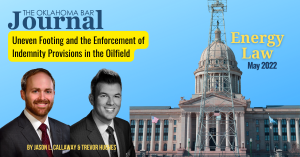Oklahoma Bar Journal
Uneven Footing and the Enforcement of Indemnity Provisions in the Oilfield
By Jason L. Callaway & Trevor Hughes
 Not unlike other industries,companies in the oil and gas industry prefer to have their independent contractors sign a lengthy (one might say unwieldy) contract before beginning any work. This contract, frequently referred to as a master service agreement (MSA) or similar title, binds the contractor to perform some currently unspecified work for the company for an unspecified price, all of which is to be agreed upon later through a work order.1 The purpose of these MSAs is to make it so any future work will be subject to the same general terms and conditions, leaving agreement about specific work to future negotiation.2 As a result, MSAs tend to be filled with the types of contract provisions that are only ever of interest to lawyers: termination, force majeure, waiver, assignment, insurance, etc., etc.
Not unlike other industries,companies in the oil and gas industry prefer to have their independent contractors sign a lengthy (one might say unwieldy) contract before beginning any work. This contract, frequently referred to as a master service agreement (MSA) or similar title, binds the contractor to perform some currently unspecified work for the company for an unspecified price, all of which is to be agreed upon later through a work order.1 The purpose of these MSAs is to make it so any future work will be subject to the same general terms and conditions, leaving agreement about specific work to future negotiation.2 As a result, MSAs tend to be filled with the types of contract provisions that are only ever of interest to lawyers: termination, force majeure, waiver, assignment, insurance, etc., etc.

monamakela.com | #2929169 | stock.adobe.com
One of these clauses deserves a second look: the indemnity provision. Or, more specifically, the part of the indemnity provision that requires a contractor to indemnify the company for the company’s negligent or intentional actions. These provisions are usually written in the finest legalese – sentences that take up half a page, more punctuation than you know what to do with, etc. – but can be boiled down as follows: “Contractor agrees to indemnify Company against all claims for damages asserted against Company that are in any way related to this agreement regardless of who may be at fault and even though Company may have caused the damages.”3
Before diving into why these indemnity provisions need another look, some brief background is in order. Generally speaking, an indemnity agreement is one where a party “engages to save another from a legal consequence of the conduct of one of the parties, or of some other person.”4 Oklahoma law recognizes the validity of these kinds of agreements.5 However, the law takes a dim view of any attempt to require one party to indemnify another party for the other’s own negligence. Those indemnity provisions are “strictly construed,” and “[t]o be enforceable, such an agreement must be ‘unequivocally clear from an examination of the contract.’”6Additionally, the indemnity agreement must have been made as part of an “arm’s-length transaction between parties of equal bargaining power,” and the provision cannot violate public policy.7 If these provisions are so hard to enforce, you may ask yourself, “Why do these indemnity provisions need another look in oilfield MSAs?”
CONFLICTING INTERPRETATIONS
Because they may not be valid at all, that’s why – and they’re likely in an awful lot of MSAs. Oklahoma, like many states, has a statutory prohibition against these types of indemnity provisions, 15 O.S. §221. That anti-indemnity statute states, “Any provision in a construction agreement that requires an entity … to indemnify … another entity against liability … which arises out of the negligence or fault of the indemnitee … is void and unenforceable as against public policy.”8 The phrase that should stand out when reading that sentence is “construction agreement.” A construction agreement is any agreement “for construction, alteration, renovation, repair, or maintenance of any building, building site, structure, highway, street, highway bridge, viaduct, water or sewer system, or other works dealing with construction, or for any moving, demolition, excavation, materials, or labor connected with such construction.”9
Here’s the rub when it comes to §221: No one can say for sure how it will be applied when it comes to working in the oilfield. There simply aren’t that many cases interpreting the statute’s language, but there is already some conflict amongst the case law that does exist. On one hand, there seems to be no real dispute the initial building of structures as part of an oil and gas operation fits within §221’s meaning.10 But what about other kinds of work done on a well site, particularly after it is operating? Here is where things get tricky.
On one hand, a federal district court in North Dakota has said that simply servicing an existing well is not covered by §221’s exclusion. At issue in Continental Resources Inc. v. Rink Construction, Inc. was a contract to “pull apart flowline due to frozen choke/unthaw and unblock flowline/bleedoff casing pressure” at a producing well.11 In the process of completing the work, one of the defendant’s employees was injured, and he subsequently sued Continental, the well’s owner and operator.12 Continental sought indemnity from the defendant, Rink Construction, based on the terms of the MSA; Rink sought to avoid indemnity under §221, arguing the agreement was a “construction agreement.”13 The court agreed with Continental, holding the agreement was for “repair and maintenance on an oil and gas well” and “d[id] not call for any construction activities.”14 It found Colorado’s anti-indemnity provision to be similar to Oklahoma’s and therefore gave weight to case law interpreting Colorado’s provision to exclude operation of a well site from the meaning of “construction agreement.”15 The court’s holding in Rink represents a likely interpretation of §221 and one that would exclude a substantial amount of work done in the oilfield other than the actual erection of structures.
On the other hand, you have a case like BNSF Railway Company v. Morrison Grain & Ag Services, Inc. that dealt with a lease contract, not in the oilfield context. Plaintiff BNSF agreed to lease defendant Morrison Grain a specific parcel of land for the latter’s operation of a grain and fertilizer facility.16 The lease included an indemnity provision requiring Morrison Grain to indemnify BNSF for BNSF’s own negligence, a provision that was tested following a fatal train accident involving a Morrison Grain employee.17 The court, in analyzing the issue, focused on §221’s inclusion of the “maintenance of any building, building site, [or] structure” within the meaning of “construction agreement.” With that language in mind, the court concluded the lease, which generally required Morrison Grain to keep the property in good condition and permitted it to use and occupy a building, fit within §221.18 While the court ultimately did not void the indemnity provision in Morrison Grain,19 its interpretation of the statute appears much more liberal than the one in Rink. It is not hard to imagine a court following Morrison Grain concluding the work done in Rink, which could be considered “maintenance” to a “structure” to be within the meaning of “construction agreement” in §221.
A WIDER PERSPECTIVE
You may now be asking yourself how other states handle this same issue and if that may shed some light on this issue. The answer is, unfortunately, still complicated. As with so many areas of law, many states have adopted anti-indemnity statutes like §221, but few are identical.20 A couple of states, such as Illinois and Nebraska, have statutes that are substantially similar to §221.21
Looking at decisions from these states offers some potential guidance, though not always uniform. Nebraska case law, for example, teaches that a contract for the repair and repainting of underground storage tanks is subject to that state’s anti-indemnity statute,22 but an ordinary contract for commercial property management is not subject to the statute even where the contract includes building maintenance.23 Cases applying Illinois’s anti-indemnity statute have held that a rental contract for equipment used at a construction site was not within that statute’s reach because, “A contract ‘for’ construction does not mean a contract ‘about,’ ‘related to,’ or ‘in connection with’ construction.”24 The case law of these states may offer some help in case-specific situations, but they are not always useful for extrapolating any type of overarching guidance in the context of the energy industry.
What makes the issue more difficult for Oklahoma’s energy companies is that many of the nearby states where exploration and production are occurring have different systems, and one, in particular, deserves special mention. Texas has adopted the Texas Oilfield Anti-Indemnity Act (TOAIA), which states that any provision in “an agreement pertaining to a well for oil, gas, or water or to a mine for a mineral is void” if it would indemnify a party against that party’s own liability.25 However, the TOAIA has a specific exclusion to its operation: It “does not apply to an agreement that provides for indemnity if the parties agree in writing that the indemnity obligation will be supported by liability insurance coverage.”26 In other words, a company can require a contractor to indemnify the company for the company’s own negligence as long as the parties agree the indemnity is secured by insurance and certain other requirements are met. Interestingly, whether either party obtains insurance appears to be immaterial; what matters is the agreement to obtain insurance.27
How this very different statutory structure affects Oklahoma companies and contractors should not be taken lightly. As discussed at the beginning of this article, companies typically draft their MSAs for use with all contractors without specifying where the work will be done. Thus, companies doing work in Texas may choose to take advantage of the TOAIA’s exception and require contractors to purchase insurance covering the company’s negligence, even though that provision may be void outside of Texas. That, in turn, leads to what is certain to be all of our fondest hopes: pinning a client’s position in litigation on the uncertain outcome of the court’s conflict of laws analysis. There have now been numerous decisions where various courts have had to address whether Texas law or the law of some other state applies in order to determine whether an indemnity provision is valid.28 While we could wish for uniformity in the results of these cases, our own review of several of these cases has shown that consensus is decidedly lacking.
AN EXAMPLE
Below is an example of an indemnity provision that likely would not run afoul of §221’s provisions:
Indemnity in Favor of Company, by Contractor:
To the fullest extent permitted by law, Contractor shall defend, indemnify and hold harmless Company, its agents, consultants, officers, directors, and employees (“the Indemnified Parties”) … from and against any and all claims, damages, losses, and expenses, of whatever kind or nature, occurring at any time, including but not limited to attorney’s fees, expert fees, and any costs incident thereto, which the Indemnified Parties may suffer or incur by reason of bodily injury, including death, to any person or persons, or by reason of damage to or destruction of property including the loss of use thereof, arising out of or connected to the Work to be provided pursuant to this MSA, except to the extent of any act, omission, or negligence of any
of the Indemnified Parties as stated above.
This language identifies
1) the persons or entities to be indemnified, 2) the risks of loss included, 3) the time frame and
4) the scope or applicability of the provision. Most importantly for purposes of §221, the language specifically excludes from the scope of coverage any damage caused by the negligence of the persons or entities to be indemnified. The authors recognize that very few companies possessing negotiating power over their contractors are likely to resort to such a “limited” indemnity provision, but it is that very unwillingness that could lead to a complete loss of indemnity if a broader provision is used.
CONCLUSION
So how are we to counsel clients when they ask whether a particularindemnity provision will be void under §221? The answer is carefully, as always. With the law uncertain, the prudent course would be to assume the courts’ interpretation will be unfriendly to your client – operators should assume indemnity provisions will always be stricken down, while contractors should assume they will always be upheld. Then, to paraphrase George Will, you will either be proven right or pleasantly surprised.29
If truly put under the gun and forced to choose one interpretation or the other in the usual indemnity agreement, we think Oklahoma’s courts will eventually adopt a more liberal interpretation of §221 as applied to oil and gas cases. As discussed at the beginning of this article, Oklahoma law requires any agreement to indemnify for the indemnitee’s own negligence to be clearly evidenced and subject to strict construction. That evidences a general disapproval of such agreements, and §221 appears to put the Legislature’s force behind that disapproval in the context of construction agreements. Given that, we would be unsurprised to see Oklahoma’s appellate courts adopt a broader, more expansive interpretation of §221.
In the meantime, we will simply have to live with uncertainty until a few more of these cases work their way through to decision.30
Authors’ note: The authors wish to give special thanks to Blair Dancy of Cain & Skarnulis PLLC for the inspiration for this article.
ABOUT THE AUTHORS
 Jason L. Callaway is a senior associate attorney with Johnson & Jones PC in Tulsa, who practices in all areas of civil litigation. He is a 2014 graduate of the OU College of Law and is a former clerk of Judge Claire V. Eagan.
Jason L. Callaway is a senior associate attorney with Johnson & Jones PC in Tulsa, who practices in all areas of civil litigation. He is a 2014 graduate of the OU College of Law and is a former clerk of Judge Claire V. Eagan.
 Trevor Hughes is a litigation/trial attorney for Johnson & Jones PC. He frequently represents construction contractors, oil and gas contractors and transportation companies in cases involving personal injury and property damage. Mr. Hughes doesn’t often dream of indemnity contracts when his head hits the pillow; however, he’s seen quite a few.
Trevor Hughes is a litigation/trial attorney for Johnson & Jones PC. He frequently represents construction contractors, oil and gas contractors and transportation companies in cases involving personal injury and property damage. Mr. Hughes doesn’t often dream of indemnity contracts when his head hits the pillow; however, he’s seen quite a few.
- Cf. Grand Isle Shipyard, Inc. v. Seacor Marine, LLC, 589 F.3d 778, 787 n.6 (5th Cir. 2009) (noting this type of two-stage agreement is common in the oil and gas industry).
- Cf. Higby Crane Servs., LLC v. Nat’l Helium, LLC, 703 Fed. Appx. 687, 692 (10th Cir. 2017) “The purpose of the MSA is to supply the ‘general terms and conditions’ governing any future contracts into which the parties may enter.”
- Readers may refer to JP Energy Mktg., LLC v. Commerce & Indus. Ins. Co., 2018 OK CIV APP 14, ¶30, 412 P.3d 121, 130, for two examples of such provisions.
- 15 O.S. §421.
- Fretwell v. Prot. Alarm Co., 1988 OK 84, 764 P.2d 149, 153.
- Estate of King v. Wagoner Cty. Bd. of Cty. Comm’rs, 2006 OK CIV APP 118, ¶50, 146 P.3d 833, 844 (quoting Fretwell, 764 P.2d at 153).
- Am. Energy-Permian Basin, LLC v. ETS Oilfield Servs., LP, 2018 OK CIV APP 44, ¶18, 417 P.3d 1282, 1287 (quoting Transpower Constructors v. Grand River Dam Auth., 905 F.2d 1413, 1420 (10th Cir. 1990)).
- 15 O.S. §221(B).
- Id. §221(A).
- See, e.g.,JP Energy, 2018 OK CIV APP 14, at ¶30 (discussing contracts to build a new pipeline); BITCO Gen. Ins. Corp. v. Commerce & Indus. Ins. Co., CIV-15-206-M, 2017 WL 835197, at *1 (W.D. Okla. March 2, 2017) (same).
- Continental Resources Inc. v. Rink Construction, Inc., 352 F. Supp. 3d 928, 934 (D.N.D. 2018).
- Id. at 931.
- Id. at 933.
- Id. at 934.
- Id. at 934-935 (citing Williams v. Inflection Energy, LLC, No. CIV.A. 4:15-00675, 2015 WL 4952626 (M.D. Pa. Aug. 19, 2015)).
- BNSF Railway Company v. Morrison Grain &
Ag Services, Inc., Case No. CIV-15-1055-SLP, 2018 WL 11373519 (W.D. Oct. 1, 2018). - Id. at *3-4.
- Id. at *5.
- The lease in question predated the passage of §221, and the court found the statute was not retroactive. Id. at *6.
- See JP Energy, 2018 OK CIV APP 14, at ¶30 (citing Dean B. Thomson & Colin Bruns, “Indemnity Wars: Anti-Indemnity Legislation Across the Fifty States,” 8 J. Amer. College of Constr. Lawyers 1, 1 (August 2014)).
- 740 Ill. Comp. Stat. Ann. 35/1; Neb. Rev. Stat. Ann. §25-21,187.
- Anderson v. Nashua Corp., 251 Neb. 833, 837, 560 N.W.2d 446, 449 (1997).
- Kuhn v. Wells Fargo Bank of Nebraska, N.A., 278 Neb. 428, 446, 771 N.W.2d 103, 119 (2009).
- Wilda v. JLG Indus., Inc., 470 F. Supp. 3d 770, 802 (N.D. Ill. 2020).
- Tex. Civ. Prac. & Rem. Code Ann. §127.003 (West).
- Tex. Civ. Prac. & Rem. Code Ann. §127.005 (West).
- See Nabors Corp. Servs., Inc. v. Northfield Ins. Co., 132 S.W. 3d 90, 96-97 (Tex. Ct. App. – Houston 2004).
- E.g., Cannon Oil & Gas Well Servs., Inc. v. KLX Energy Servs., L.L.C., 20 F.4th 184, 186 (5th Cir. 2021) (comparing Texas and Wyoming law); Chesapeake Op., Inc. v. Nabors Drilling USA, Inc., 94 S.W.3d 163 (Tex. Ct. App. – Houston 2002) (comparing Texas and Louisiana law).
- The full quote attributed to Mr. Will is, “The nice part about being a pessimist is that you are constantly being either proven right or pleasantly surprised.”
- It’s worth noting that further ambiguity remains for exploration. No case addressing §221 has addressed what the term “structure” means in context, for example. This is particularly relevant in the oilfield, where opinions may differ as to whether something is a “structure” or is, instead, mere equipment or machinery.
Oklahoma Bar Journal – OBJ 93 Vol 5 (May 2022)
